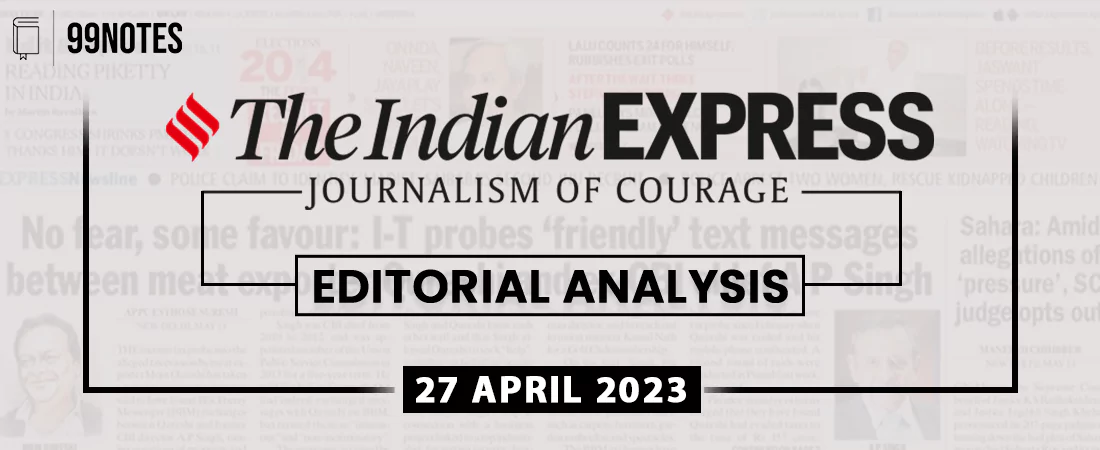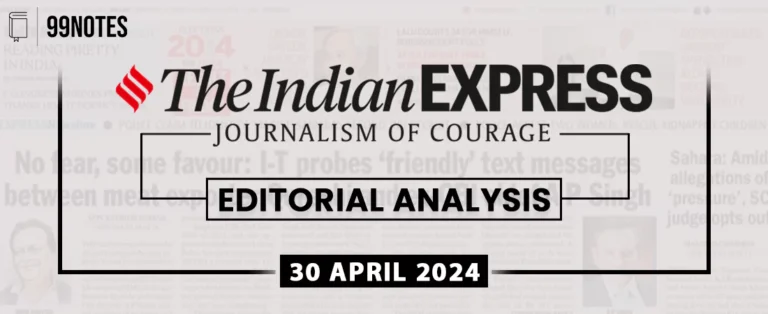27 April 2024 : Indian Express Editorial Analysis
Indian Express Editorial Analysis
27-April-2024
1. ROBUST AND TRANSPARENT
| Topic: GS2 – Governance – Government policies – Interventions for development in various sectors
This topic is relevant for both Prelims and Mains as the article discusses a recent decision by the Supreme Court regarding Electronic Voting Machines (EVMs) and Voter Verifiable Paper Audit Trail (VVPAT) slips. |
| Context: |
|
Critique Against EVMs:
- The critique against EVMs, as highlighted in the courtroom and by opposition leaders, lacks factual consistency and evidence.
- The narrative appears to be politically motivated, aimed at undermining the credibility of Prime Minister Narendra Modi’s administration rather than addressing genuine concerns about the electoral process.
- The inconsistency of opposition parties’ stance on EVMs, depending on their electoral fortunes, raises questions about the sincerity of their criticism.
- For instance, parties like the Indian National Congress (INC) raised objections to EVMs only after experiencing electoral setbacks post-2014.
Patterns of Opposition Strategy:
- A pattern emerges where the opposition’s skepticism towards EVMs seems to serve as a cover for their electoral failures.
- This selective skepticism transforms into a concerted strategy to discredit the electoral process, particularly as they anticipate unfavorable outcomes in upcoming elections.
- By casting doubt on EVMs, the opposition aims to preemptively dispute election results, thereby eroding public trust in the electoral process.
Implications and Recommendations:
- The Supreme Court’s timely decision to uphold the reliability of EVMs, supplemented by VVPATs, counters the opposition’s narrative and reinforces the integrity of the electoral process.
- However, it calls for genuine introspection from the opposition to shift focus from baseless narratives to addressing real issues faced by the electorate.
- Moreover, the opposition’s tendency to litigate political battles in the Supreme Court detracts from constructive engagement with democratic processes.
- Instead, they should prioritize addressing electoral concerns through political channels.
Conclusion:
- The conclusion highlights the significance of EVMs in facilitating free and fair elections and commends the Election Commission of India (ECI) for its diligent efforts.
- It emphasizes the importance of upholding the integrity of the electoral process and encourages all stakeholders to work towards fostering public trust and participation in democracy.
| About Electronic Voting Machine VVPAT |
About:
Key Features:
Benefits:
Concerns:
What is VVPAT? About:
Related Supreme Court Ruling:
|
| PYQ: In the light of recent controversy regarding the use of Electronic Voting Machines (EVM), what are the challenges before the Election Commission of India to ensure the trustworthiness of elections in India? (150 words/10m) (UPSC CSE (M) GS-2 2018) |
| Practice Question: Critically analyze the Supreme Court’s recent ruling on Electronic Voting Machines (EVMs) and Voter Verifiable Paper Audit Trail (VVPAT) slips, highlighting its implications for the integrity of the Indian electoral process. (250 words/15 m) |
2. Amir Garib
| Topic: GS3 – Indian Economy – Inclusive Growth This topic is relevant for both Prelims and Mains as the article provides insights into the historical context and evolution of wealth redistribution policies in India, shedding light on socio-economic issues such as income inequality, land reforms, and economic policies. |
| Context: |
|
Socio-Economic Landscape:
- At the time of Independence, India was marked by significant wealth disparities, with a large portion of wealth held in the form of land.
- Land reforms were seen as crucial in addressing this inequality, leading to measures such as the abolition of the zamindari system and the imposition of land ceilings.
- Despite efforts to redistribute land to tillers, the implementation of these reforms faced challenges due to a lack of political will and administrative inefficiencies.
Political Acceptance of Redistribution Policies:
- During this period, there was broad political consensus on implementing measures aimed at redistributing wealth and addressing inequality.
- Legislation such as land reforms, nationalization of industries, and progressive taxation enjoyed widespread acceptance, with minimal political resistance.
- The Swatantra Party emerged as a lone voice opposing these measures but failed to garner significant support from the business class.
Shift in Economic Policies:
- Over time, there has been a shift in economic policies, marked by the removal of estate duty and the implementation of economic reforms in 1991.
- Businessmen are now celebrated as wealth creators, reflecting a change in popular attitudes towards wealth accumulation and entrepreneurship.
Changing Economic Landscape:
- The economic landscape has witnessed significant changes, with wealth becoming increasingly financialized and dispersed among a larger section of society.
- The rise of financial instruments like bank deposits, mutual funds, and shareholdings has contributed to a more widespread distribution of wealth.
- However, income and wealth inequality have also risen, with the top percentile capturing a growing share of national income and wealth.
Political Implications and Policy Shifts:
- The changing socio-economic dynamics have led to a reevaluation of traditional approaches to wealth redistribution.
- Policies focusing on job creation, education, skill development, and progressive taxation are seen as more viable alternatives to radical redistribution.
- The withdrawal of the 2014 land acquisition act amendments and the 2016 demonetization are indicative of a shift away from expropriatory measures towards more nuanced policy interventions.
Conclusion:
- The historical evolution of wealth redistribution in India reflects broader socio-economic transformations and shifting political ideologies.
- While the concept of redistributive policies enjoyed widespread acceptance in the past, changing economic realities and political dynamics have necessitated a reevaluation of traditional approaches to addressing income and wealth inequality.
| Causes of Increasing Inequality Despite High Economic Growth in India |
Wealth Accumulation:
|
| Practice Question: Critically analyze the evolution of wealth redistribution policies in India from the 1950s to the present, considering their socio-economic impact and political implications. Suggest policy interventions to promote equitable economic growth and social justice in India. (250 words/15 m) |
For Enquiry
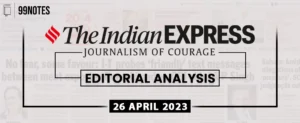
27 April 2024 : Indian Express Editorial Analysis

26 April 2024 : Daily Current Affairs Quiz

26 April 2024 : Daily Answer Writing
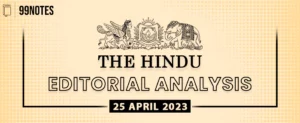
26 April 2024 : The Hindu Editorial Notes PDF
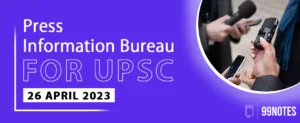
26 April 2024 : PIB Summary for UPSC

26 April 2024 : Indian Express Editorial Analysis

26 April 2024 : Daily Current Affairs

25 April 2024 : Daily Current Affairs Quiz

25 April 2024 : Daily Answer Writing

25 April 2024 : The Hindu Editorial Notes PDF
April 2024 Indian Express 27 April 2024 : Indian Express Editorial Analysis Indian Express Editorial Analysis
26-April-2024
1. ROBUST AND TRANSPARENT
Topic: GS2 – Governance…
Daily Quiz 26 April 2024 : Daily Current Affairs Quiz 26- April 2024 : Daily Quiz…
mains answer writing 26 April 2024 : Daily Answer Writing Mains Answer Writing
26-April-2024
Q1) Discuss the multifaceted significance of the fisheries sector…
April 2024 The Hindu Editorial 26 April 2024 : The Hindu Editorial Notes PDF The Hindu EDITORIAL
26-April-2024
1. Questioning the polls ‘rain washes out play’ moments
Topic:…
April 2024 PIB 26 April 2024 : PIB Summary for UPSC PIB Summary for UPSC
26-April-2024
1. Council of Scienific & Industrial Research (CSIR)- National…
April 2024 Indian Express 26 April 2024 : Indian Express Editorial Analysis Indian Express Editorial Analysis
26-April-2024
1. Health on a hot planet
Topic: GS1 – Geography…
April 2024 Daily Current Affairs 26 April 2024 : Daily Current Affairs Daily Current Affairs
26-April -2024- Top News of the Day
1. Ocean floor holds vital clues on weather…
Daily Quiz 25 April 2024 : Daily Current Affairs Quiz 25- April 2024 : Daily Quiz…
mains answer writing 25 April 2024 : Daily Answer Writing Mains Answer Writing
25-April-2024
Q1) What is regenerative agriculture? How is it helpful in addressing…
April 2024 The Hindu Editorial 25 April 2024 : The Hindu Editorial Notes PDF The Hindu EDITORIAL
25-April-2024
1. The Indian seafarer deserves better in choppy high seas
Topic:…

